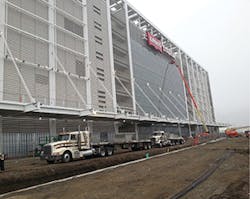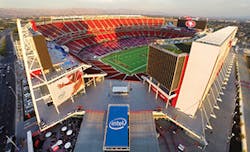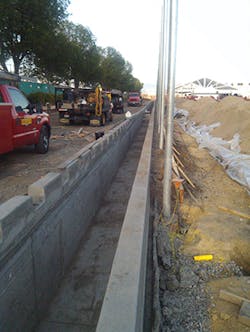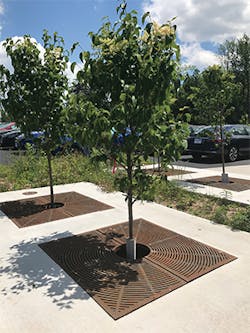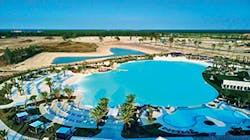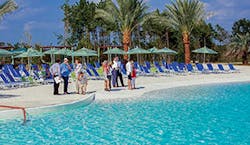Many of the drainage and filtration systems explored in this article look like ordinary planter boxes, housing anything from flowers and groundcover to full trees. That’s not all, however. They can be disguised as ramps and entranceways to venues in ways that are pleasing to the eye and yet filter stormwater at the site. Through the use of ultrasonic and sound waves, it is possible to install large man-made lagoons and lakes at developments; the water quality is monitored via the cloud far from the site. Water filtering and cleaning in the future will look very different even than it does today.
Levi’s Stadium
In 2011, Oldcastle Infrastructure, headquartered in Atlanta, GA, was selected by project engineering firm GHD (previously Winzler & Kelly) to supply the BioMod Modular Bioretention System to handle the stormwater runoff at the San Francisco 49ers Stadium in Santa Clara, CA. The stadium, built to seat up to 70,000 people, also required large parking facilities. These parking areas and the associated runoff demanded a stormwater collection system that could handle the substantial quantity.
The deputy director of public works for Santa Clara, Dave Staub, explains the storm drain collection system that was needed. “The Levi’s Stadium construction project was subject to the new development requirements set forth in provision C.3 of the San Francisco Bay Region’s National Pollutant Discharge Elimination System Permit. The stadium development was on land owned by the City of Santa Clara, so Department of Public Works engineering staff reviewed all of the onsite and offsite drainage plans for the project. A series of about 20 CDS units were installed onsite, and the field drainage is plumbed to the sanitary sewer system to avoid discharge into the storm drain collection system. The City subsequently installed Revel Environmental Manufacturing full-trash-capture devices in individual catch basins surrounding the stadium about two years ago. The Forty Niners Stadium Management Company is in charge of maintaining the stormwater treatment devices.”
Additionally, he notes that the stadium has a 27,000-square-foot green roof. Other sustainability features include using recycled water for the landscape irrigation, toilets, and urinals, and water-conserving fixtures. The stadium recycles or salvages up to 75% of non-hazardous construction waste. The Levi’s Stadium was the first professional football stadium in the US to receive LEED Gold certification when it was constructed.
When the San Francisco 49ers originally looked for a new stadium site in 2006, Candlestick Park was the proposed choice. But negotiations fell through, and at that point, the area adjacent to their training facility in Santa Clara seemed like a natural. Voters approved the creation of the Santa Clara Stadium Authority (SCSA) in 2010 to raise funds, authorizing construction and building of the stadium. The SCSA is structured to be responsible for debts or obligations, rather than the City of Santa Clara having that liability.
“The Stadium Authority was established to operate Levi’s Stadium separately and distinctly from the City of Santa Clara,” says Lenka Wright, the city’s director of communications. “That being said, I think it’s important to note that seven elected members of the city council serve on the Stadium Authority Board. The mayor is the chairman of the Stadium Authority, the city manager is the executive director, and the city attorney is the authority’s general counsel.”
As the Stadium Authority developed and authorized decisions for the construction to begin in 2011, construction teams had to look toward infrastructure and existing utilities on the site, including the stormwater plans.
Less than 6 miles from the stadium, the Guadalupe Slough receives water from San Tomas Aquino Creek, a tributary that runs adjacent to the site. The slough flows into the ecologically sensitive San Francisco Bay. Adding to the environmental challenges for stormwater planning at the site was the high water table. Because existing storm drain pipes are located not far below the ground surface, an infiltration system would not work for this location.
The overall site was designed by HNTB, an architectural firm in Los Angeles. Working collectively, Turner Construction and Devcon Construction compiled the integrated design-build and construction delivery system. The Ghilotti Construction Company was awarded an overall contract of $10.4 million to conduct site research and manage the relocation of underground utilities on the 14-acre site.
Preston Pipelines in Milpitas was awarded a $3.5 million contract to do onsite underground utility installation for the stadium. The work included excavations on the west stadium, onsite storm drains with multiple media filters, and Oldcastle’s BioMod biofiltration unit installations. The work also involved onsite sanitary sewer service, domestic water feed, fire protection service, onsite reclaimed water services, and utilities at the Great America parking lot adjoining the stadium.
BioMods are conventional, concrete bioretention systems that remove total suspended solids (TSS), metals, solids, nutrients, and trash and debris by means of filtration, sorption, and biological uptake. The BioMod is ideal for parking lots as it removes TSS from stormwater runoff. The system is delivered as individual modular precast sections that can be set in a series to form a stormwater treatment train. They can be custom made for specific sites like the stadium location. In total, 2,500 linear feet of bioretention cells were installed, with 15,000 square feet of total bioretention surface area.
Six of the BioMod biofiltration units were installed in the parking lots and grounds surrounding and adjoining the stadium. That’s where the challenges began from the start. The first two units needed to be installed before stadium construction contracts had even been awarded.
The Parking Lot and Practice Field
“This $12 million ‘stadium-make-ready-work’ project was one of the first projects awarded by the Santa Clara Stadium Authority,” says Brad Simpkins, vice president of private and commercial work with Ghilotti Construction Company. “It involved the relocation of the existing main underground arterials—high-voltage electrical power, domestic water, reclaimed water, storm drain, and sanitary sewer lines—to clear the way for the new stadium.
“The practice field roadways and parking lots were designed to incorporate a bioretention storm drainage system, the BioMod retention system, which was to be connected directly to the existing storm drain facilities. The BioMod system consisted of precast concrete channels and integral precast boxes and was ultimately filled with an engineered ‘five-inches-per-hour’ soil blend,” he says.
“The precast channels were delivered and set in the field utilizing typical construction equipment,” notes Simpkins. “The precast channels were then finished off by hand, forming the top-notched curbs on the pavement side and heightened back walls for sidewalks or the grass playfield to account for the finished surface design elevations.”
The three BioMod units were installed on either side of the practice fields as treatment for the parking lots. These were long, narrow units with mulch on top, but no trees or living plants. The pipes located in these units lead straight into the storm drain proper, says Simpkins.
He explains that the parking lot surface grade varied, making it a little challenging for the Ghilotti crew. The modules were installed basically, but afterward, crews had to pour a notched top to be able to join them to the sidewalk.
“All of that on top had to be poured and hand-formed,” recalls Simpkins. “The precast units went in in about 10 days, where that hand work took literally weeks of work.”
West Side of Stadium
Preston Pipelines project executive Jordan Thomas ordered the BioMod units from KriStar, now Oldcastle Infrastructure. “There were two main large units west of the stadium, but smaller ones of different types were also installed in the parking lots to capture hydrocarbons,” he explains.
The smaller modules were located off the practice field parking lots, and larger ones were installed off the pedestrian walkway alongside the stadium. “We had pretty tight tolerances,” he says. “On one side was a footing, below ground, with the perimeter fence on top, and we had to dig alongside that in order to make the installation. Another challenge was presented with the multiple trees within each BioMod unit. They had to align perfectly with the grid lines on the stadium building.”
Beginning the construction, Preston’s crew dug the sections where the 10-ton BioMod modules would sit. Each area was laid with crushed leveling rock and leveled to precision. The biofiltration sections, each 3.25 feet, were installed to allow room for the top mulch, says Thomas.
“They had to be perfectly level or it wouldn’t join up correctly. Only a 3/4-inch tolerance was allowed with each BioMod precast section,” he says.
After installing the 278-foot and the 229-foot sections, crews used construction tape or adhesive to seal any gaps. “These two large systems on the west side of the stadium were like big concrete bathtubs filled with filtration media. Water drains off the walkways and the units capture it. Then it percolates down through the media into the perforated pipe and flows out to the normal gravity-fed storm drain,” he says.
Using the size of the lot and predicted rainfall, engineers computed the required size of the bioretention system. Santa Clara County requires media blends to infiltrate 5 to 10 inches per hour.
The previously mentioned high water table posed the biggest challenge for construction teams to install the BioMod systems. The closed-bottom systems could handle the runoff but would be shallow in the ground. Although BioMod are custom-designed modules, these conditions dictated that they be much shallower than the standard BioMod. The available filtration depth was therefore reduced, requiring an increased bioretention surface area.
In one parking area, the extra-wide module was placed perpendicular to the main system. Each module drains 7,500 to 10,000 square feet of parking area. This section in particular was laid out with a large rounded end, somewhat resembling the shape of a hockey stick. The modules are 7 feet wide and divide the parking lot into six drainage management areas.
Levi’s Stadium actually opened in 2014. The first sporting event hosted there was a Major League Soccer match in August 2014. That same month, the 49ers got their first chance to play in the new stadium with a pre-season game against the Denver Broncos. In February 2016, Super Bowl 50 was hosted there, and between 2014 and 2016, the stadium hosted the Pac-12 Football Championship Games. The PAC-12 Championship game between the University of Southern California and Stanford was hosted at Levi’s Stadium in 2017.
Ralph Honda, Rochester, NY
When owners of the Ralph Honda dealership in Rochester, NY, decided to renovate and expand the facility, they knew they wanted to go all out and add new features to enhance its public image.
Steven Ralph, president of Ralph Honda, explains why. “Honda has a program for dealers who want to participate,” he says. “And with the things we did, especially in the new building and the parking lot, we were honored with the Honda Environmental Leadership Award in 2018 for our efforts to reduce our environmental impact.”
The dealership expanded its showroom, added new service bays and a new car wash, and renovated the parking lot areas, adding 15,160 square feet of building space and 1.74 acres of new asphalt pavement. Ralph adds that the renovation was something that was planned in any case, but the dealership’s added efforts paid off.
“We achieved Gold status in the Honda program with the new building because our HVAC system is efficient and we installed 100% LED light all throughout. But the stormwater management measures we took were really the thing,” he notes.
Because the redevelopment project increased the site’s overall impervious surface area, additional water-quality regulations from the New York State Department of Environmental Conservation (DEC) needed to be met. Part of the regulations included 80% TSS removal. The dealership also had to demonstrate that its runoff volume was reduced and comply with a critical regulation in New York for phosphorus removal.
The redevelopment at Ralph Honda was required to reduce phosphorus by 40%. The DEC is strict about phosphorus with levels set at 20 microns per liter. All phosphorus-based detergents have been totally banned, which means they can’t be purchased in New York. Additionally, the state’s Nutrient Runoff Law prohibits any sale of phosphorus-containing detergent of any type at the retail level. Phosphorus fertilizer is highly regulated as well, and homeowners are educated frequently about its effects on water quality. With Rochester being located on the southern shore of Lake Ontario, the regulations are mandatory.
Richard Giraulo of LandTech Surveying & Planning LLC explains that in New York, redevelopment sites have to meet different criteria than new construction. The area also has a high water table, which was one of the deciding factors for the type of stormwater management used.
“Because of the high groundwater table here, water could not infiltrate to the ground,” he says. “We needed boxes to separate the water from the groundwater. So it had to be a closed-box system.”
Giraulo worked directly with Contech’s local stormwater consultant Kate Glode to explore various stormwater options for the site. Two challenges they had to overcome were the high groundwater and limited space. These required a manufactured system. Giraulo decided on Contech’s Filterra bioretention system to meet the criteria for water-quality treatment and to reduce runoff.
“On that site, we ended up with three Filterra units,” he says. “The parking lot sizes were 0.61 acres, 0.63 acres, and 0.82 acres, and all of the units we installed were the same 7-by-13 units. The water-quality values for each one were, respectively, 1,614 cubic feet, 1,977 cubic feet, and 2,240 cubic feet. The two smaller units both had flow rates of 0.94 cubic feet per second, and that third one, the larger one, had a flow rate of 1.22 cfs.”
These units were the Filterra Standard Offline, Contech’s most economical and simplest configuration. They worked well at Ralph Honda because the Filterra Standard allows for a shallow profile—ideal because of the high water table—and uses a catch basin.
The units’ specially engineered biofiltration media is a homogenous mixture of specific grades of washed aggregate and organic material from planted vegetation on top. The Filterra filter media is enhanced to work under high flow rates, like those needed at Ralph Honda. Even under high flow rates, the media functions to maintain its pollutant removal performance. In the root zone where plants, grasses, or trees have their roots and leaf litter, the media supports adsorption of the pollutants via a biological storage and uptake, while microbes consume other pollutant components.
The approach to managing the stormwater runoff from the parking lot was unique in order to maintain a reasonable cross slope to the parking automobile display areas. Giraulo incorporated a concrete gutter system that would collect only the frequent storm events for treatment through the Filterra units and allow the more intense storms to spill over the gutters into traditional storm sewers.
He adds that in the event of a heavy rain event, water flows down to the storm drain system—the catch basins.
The stormwater runoff enters a Filterra system by way of a curb inlet opening, or in this case, a gutter. It flows through specially designed filter media in the concrete vaults or rectangular containers. After the media captures pollutants like hydrocarbons, they’re immobilized and decomposed into whatever is in the Filterra units, like mulch, tree roots, and other micro/macroflora. The runoff flows through this media and into the bottom of the vault; from there the treated runoff is discharged.
At the car wash, the water runs into a grease-and-oil separator and down to the sanitary system.
The Filterra boxes were easily set in place by the site contractor. Contech supplies the pre-filled planter boxes to the contractor, who is then responsible for installing them at the correct location and elevation. One of the deciding factors for using the Filterra units, explains Giraulo, was the product support and one-year maintenance and follow up. There was a sense of security with the product knowing that the supplier would inspect the units a year after activation to successful operation.
In addition to the Honda Environmental Leadership Award, Ralph Honda received another similar award that year from the American Honda Motor Company for its efforts to reduce environmental impacts. To receive the award, dealers must achieve specific environmental targets, including lowering the total energy use at their location by 10%. Steven Ralph says that in addition to the LED lighting, the facility has since installed water-efficient water fixtures and environmentally effective windows throughout the property.
Balmoral: A Planned Community With White Sand Beaches
Established in 1997, Land Tejas is one of the largest developers of planned communities in Houston, TX. It currently has more than 20 communities over 10,000 acres in the Greater Houston area. With a price range from $200,000 to $500,000, the homes are aimed at families that want the finest features when developing their neighborhoods, with top-of-the-line amenities included.
The Balmoral Lake Estates, located off the North Sam Houston Parkway in Humble, TX, is a 750-acre development that provides gated, non-gated, or lakeside homes and villages. The planned development includes approximately 2,000 home sites, a 2-acre Crystal Lagoon (see sidebar) surrounded by two man-made beaches, and an infinity pool. The community area has lakes, parks, and walking trails safe for families to enjoy. Amenities also include a 3,000-square-foot community clubhouse and a boardwalk that meanders through the parks and lagoon areas. A white sand volleyball pit and tennis courts promote community sporting teams and events.
At Balmoral Park Lakes East, the engineering firm Pape-Dawson recommended that the SciCLONE hydrodynamic separator be installed to achieve the required 80% TSS removal. Bio Clean Environmental Services, a Forterra company headquartered in Dallas, TX, manufactures the SciCLONE. Based on the testing data, the SciCLONE was sized for the correct treatment flow rate, says Zach Kent, vice president for product development and regulatory compliance with Bio Clean.
“The SciCLONE model SC-7-V provides 80% TSS removal rate at a mean particle size of 112 microns at a treatment flow rate of 3.44, which is greater than the required treatment flow rate of 2.71 cubic feet per second,” he says.
Clearwater Utilities in Cypress, TX, was hired for the SciCLONE installation. Kevin Plaisance, project manager with Clearwater, says all of the units are located in what are considered to be the regular locations—in this case, at the last manhole before each outfall, as per the engineers’ plans.
Two large SciCLONE units, each measuring 10 feet in diameter, as well as a smaller 8-foot-diameter unit were installed using an excavator, says Plaisance.
“Per specifications, we dug down to plan grade, set the unit in on top of the prepared subgrade, and backfilled,” he says. “The unit is installed like a typical manhole: excavate, install the pipe and set the units, backfill, and grout. Bio Clean installed the internal components like the weirs, deflectors, and other parts after we set the concrete structure.”
At the core of the SciCLONE is an inlet flow splitter that redirects inlet flows away from the center, out in two directions, allowing water to move to the system’s outer perimeter. The flow then moves toward the oil skimmer and along its walls, then back toward the inlet in the middle of the chamber. By creating two churning vortices, the flow path is maximized. This directs any fine sediment to settle out below the inlet.
Because the SciCLONE is specific to each site, Bio Clean recommends several inspections be done in the first year to develop baseline pollutant load data to ensure that erosion from nearby sites isn’t impacting the system. Using a flashlight to look through the access holes, it’s easy to view the inside of the system. SciCLONE data sheets recommend checking for obstructions in the inflow pipe, sump chamber, and the outflow pipes. Maintenance should be scheduled any time there is excessive accumulation in the sump chambers. If sediment measures over 18 inches deep in the sump chamber, it’s usually cause for full maintenance to be performed on the system. Maintenance is usually performed on the SciCLONE using a vacuum truck with a pressure washer attachment. It’s also recommended that maintenance duties be performed three days after a rainstorm.
The Lagoon at Balmoral
It’s easy to assume that “crystal lagoon” is simply a description of the lake located at the Balmoral home development site. Crystal Lagoons is, in fact, a world leader in water innovation and technology. The international company uses a patented, state-of-the-art technology to construct clear, clean bodies of water of various sizes to provide beaches anywhere desired. The first lagoon in the United States was installed in Florida, which currently has four of the lagoons located around the state.
Currently, Crystal Lagoons has more than 600 projects in various phases of planning, construction, and operation. The technology uses limited chemicals and energy; it involves an efficient filtration system that uses only 2% of the energy used by a conventional pool filtration system. By using ultrasonic and sound waves and a proprietary blend of additives to the water, the system agglomerates small particles into larger particles, which are then removed; this allows smaller fractions of the total water volume to be filtered.
Water quality complies with international standards and is monitored 24 hours a day, 7 days a week by strategically located sensors in a lagoon. The sensors continually report water-quality data through a cloud-based system to the Crystal Lagoons Control Center.
The 2-acre lagoon located in the Balmoral Estates ranges in depth from 3 to 8 feet. Swimming is allowed in the shallower end, and the deeper sections are used for stand-up paddle boards and kayaks. Areas of the white sand beaches are furnished with cabanas and lounge chairs. The lagoon closes two days a week for maintenance.
Solving the Coliform Problem
Some of the most difficult-to-control pollutants, particularly in recreational waters like a man-made lagoon or a lake, stream, or estuary, are bacteria and other harmful microorganisms. Bacterial contamination not only can lead to beach closures but also can prove harmful to shellfish harvesting areas.
A product has been registered with EPA for reducing coliform bacteria in stormwater. The FabGuard Antimicrobial Filter targets pathogens differently from conventional antimicrobial materials. FabGuard is made of a flexible and highly permeable foam material that allows water to pass through quickly. The foam can be formed into different shapes and sizes to fit a variety of systems. A chemical treatment applied to the foam creates a positively charged polymer coating. Unlike products that kill bacteria essentially by poisoning them, the polymer coating creates what the manufacturer, Fabco, describes as a microscopic “layer of electrically charged swords or stiff fibers extending outward from the foam surfaces.” These “swords” disrupt the microbe’s cell membrane, and the electrical charge destroys the organism. Unlike poison, which dissipates quickly, the polymer coating remains in place and effective for the life of the foam.
Fabco also provides other stormwater treatment systems, including the FocalPoint biofiltration system.

